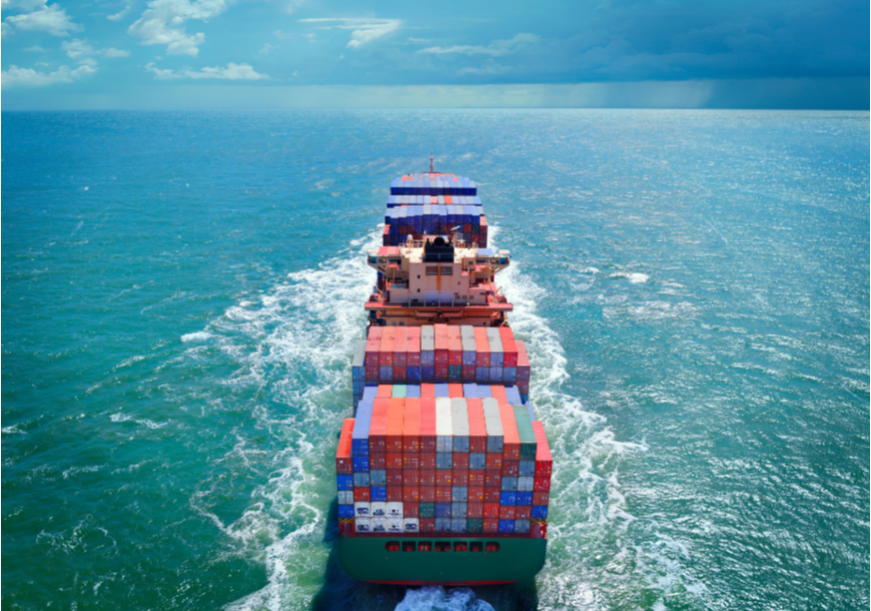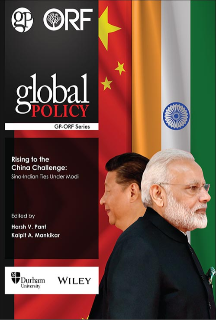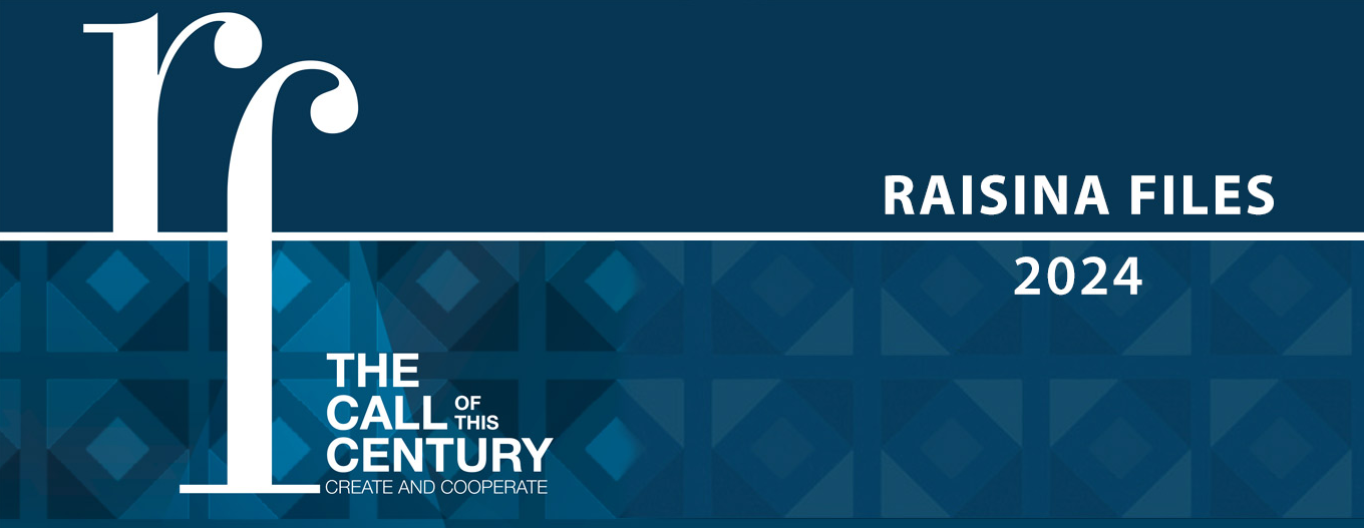
This article is a part of the series - Raisina Files 2024
The global order, it seems, was in constant turmoil in the last decade, barely held together by a web of complicated partnerships and alliances and weakening multilateral institutions. Major powers like the United States (US) and China are competing with one another for global economic dominance; Russia has upended the United Nations Charter and sent shockwaves throughout the global community by annexing Crimea in 2014 and conducting a full-scale invasion of Ukraine in February 2022; and Hamas’s attack on Israel on 7 October (and Israel’s prolonged military response) shows that the Middle East is anything but stable.
Amid the unease, danger, and destruction, it is easy to forget that the world is also in the middle of another crucial shift: a new industrial revolution. This time, the colour is green, and the aim is a cleaner, more livable world for future generations. This industrial revolution looks different from those that came before and will require unprecedented access to global critical minerals “essential to the functioning and integrity of a wide range of industrial ecosystems”, such as solar and wind farms, energy-efficient lighting, and electric vehicle battery production.[1]
These minerals include, but are not limited to graphite, cobalt, lithium, and copper used for some of the most advanced technologies of our time. The uses go beyond just clean energy, and include national defence technology as well—fighter jets, precision-guided missiles, aircraft engines, and control rods in nuclear reactors, all require access to such critical raw materials.[2] Current statistics around these minerals are nothing short of astounding: “Global demand for lithium and graphite, two of the most important materials for electric vehicle (EV) batteries, is estimated to grow by more than 4000 percent by 2040 in a scenario where the world achieves its climate goals.”[3] Demand for cobalt is expected to more than double by 2030, driven by the upside swing of the EV market.[4]
Many of these minerals are scattered throughout the globe. Chile holds the world’s largest lithium reserves, followed by Australia, Argentina, and China.[5] Türkiye and China are home to the world’s largest graphite reserves. The Democratic Republic of the Congo—where mines are the subject of attention from human rights groups for their use of child labour—possesses the world’s largest cobalt reserves and the seventhlargest copper reserves.[6]And finally, South Africa has unchallenged dominance in the production of manganese, a mineral used in both wind and solar farms and for EV batteries.[7]
Of these countries, those that can successfully harness the production of raw materials (and the supply chain logistics for those raw materials) could lead the world in both technology and clean energy into the next century.[8] For their part, states that do not have comparable natural reserves of these materials must build new industrial partnerships with those that do. In some cases, these partnerships must be between states that may otherwise view one another as competitors or even threats. In other cases, western countries must determine how to engage fairly and equally with states—mainly those in Africa—who have been on the end of extractive relationships with wealthier nations for decades. Unprecedented levels of cooperation between the Global North and the Global South will be key.
Taking all this together, the task may appear daunting. As the global race for critical minerals and leadership in the green energy transition heats up, there are a few issues that must be kept in mind to ensure that chaos and competition do not stymie growth, progress, and achievement.
U.S.-China Competition: A Bump in the Road to Securing Critical Minerals
In January 2021, United States President Joe Biden issued Executive Order 14017 as one of his first orders of business upon assuming office, directing “each department in the administration to assess potential supply-chain risks within their jurisdiction and come up with strategies to mitigate or overcome these.”[9] The aim was to “minimise supply chain disruptions domestically and internationally.”[10] The results of the directive were concerning: China was estimated to control 55 percent of global rare-earths mining capacity in 2020 and 85 percent of rare-earths refining.[11] More specifically, as professor of environmental studies, James Morton Turner, highlights: “China control[s] 58 percent of the global production of lithium compounds in 2022, 69 percent of nickel sulfate, 69 percent of synthetic graphite, 75 percent of cobalt, 95 percent of manganese and 100 percent of spherical graphite. China plays a similarly outsize role in the supply of materials used in solar panels and wind turbines.”[12]
From China’s vantage point, there is no better place to be. Not only does it give the country ample control over the role it plays in the global green transition, but it also means it can use that position to gain concessions from other countries that may challenge its dominance. Indeed, on 1 December 2023, China began “government approval for exports of graphite…in an apparent counter to US-led curbs targeting China's tech sector.”[13] This came only two months after China restricted the export of germanium and gallium, both critical to semiconductor manufacturing.
The United States is also trying to secure its spot at the top of the global critical minerals supply chain. In 2022, Congress passed a landmark legislation known as the Inflation Reduction Act (IRA), described by the White House as “the most significant action Congress has taken on clean energy and climate change in the nation’s history” which “sets forth a new era of American innovation and ingenuity to lower consumer costs and drive the global clean energy economy forward.”[14] The IRA also commits to increasing the US supply of critical raw materials to vastly expand EV production, batteries, and infrastructure for renewable power production. While the law does not say so specifically, it is clearly designed to counter China in this space.
Unfortunately, as the US and China continue to try to out-invest, out-subsidise, and challenge one another’s global economic dominance, their push-and-pull risks becoming zero-sum—if it is not already so. According to Zongyuan Zoe Liu of the Council on Foreign Relations: “US-led critical mineral supply chains initiatives that aim to counter China’s dominance inevitably clash with the Chinese government’s interests in securing mineral resources for China’s industrial development.”[15]The same goes for Chinese efforts aimed at curbing US dominance. Going forward, as difficult as it may be, it is imperative that the US and China try to find ways to cooperate in this domain. Everyone loses in a scenario where the two are locked in a classic geopolitical game of the Prisoner’s Dilemma, where each side is waiting to see if the other makes a move, and the rest of the global community gets caught in the crossfire.
The November 2023 meeting in San Francisco between presidents Joe Biden and Xi Jinping was a first step towards opening lines of communication. According to the White House, “The two leaders underscored the importance of working together to accelerate efforts to tackle the climate crisis in this critical decade;” they agreed to continue cooperation through “high-level diplomacy and interactions, including visits in both directions and ongoing working-level consultations in key areas.”[16] The US and China must include discussions on global critical raw materials supply chains as part of these high-level diplomatic efforts.
The More the Merrier: Global Partnerships are Key
The race for access to critical raw materials goes beyond just the United States and China; it is global. In a visit to the United States in May, for example, Australian Prime Minister Anthony Albanese announced a landmark plan to both mine and process critical raw materials on the continent. The two sides also announced a significant step in bilateral cooperation: “a Climate, Critical Minerals and Clean Energy Transformation Compact…establishing climate and clean energy as a central pillar of the AustraliaUnited States Alliance.”[17] This is in addition to a high-level bilateral taskforce between the two countries focused on deepening cooperation on critical raw materials and working “with industry leaders to develop and expand reliable, responsible and secure global access.”[18] Similarly, the US and Japan signed a critical minerals agreement in March 2023, which builds on the 2019 US-Japan trade agreement and highlights the “shared commitment of the United States and Japan with respect to the critical minerals sector to facilitate trade, promote fair competition and market-oriented conditions for trade in critical minerals.”[19]
The European Union (EU) is also implementing its own critical minerals policies. In March 2023, the EU proposed the Critical Raw Materials Act, which will ensure EU access to a secure and sustainable supply of critical raw materials, enabling Europe to meet its 2030 climate and digital objectives.[20] Like the US, Europe relies heavily on imports, mostly from single third countries. The Act sets out ways for the EU to create secure and resilient supply chains, lays out ways to prepare and mitigate supply chain risk, improves the sustainability of critical raw materials on the EU market, and diversifies the EU’s imports of critical raw materials.
There is no doubt that access to critical raw minerals is a top-of-mind agenda for countries around the world. What is less clear, however, is where global cooperation goes from here, and whether these bilateral and EU frameworks will be able to launch the type of partnerships that are truly needed. This is where multilateral partnerships become key. In response to European panic over the IRA’s effects on countries in the continent, European Council President Charles Michel and US President Joe Biden in March 2023 announced plans to create an EU-US Critical Minerals Agreement. The objective, of course, is to secure supply chains needed in the production of EV batteries. In addition, the aim is to give the EU “a status equivalent to US free trade agreement partners pursuant to the US Inflation Reduction Act.”[21]
The European Council has also proposed a “Brussels Buyer’s Club”—a centralised purchasing mechanism for critical minerals open to the United States and other like-minded countries. As Cullen Hendrix of the Peterson Institute for International Economics points out, though, there are flaws in the “buyer’s club” approach. He states: “Supply chains for critical minerals desperately need widening to meet projected global demand and tackle climate change mitigation. A purchasers club would not be a step in the right direction.”[22]Further, it could potentially set up distributive conflicts within the EU, and have adverse effects for just transitions in developing and middleincome economies.
What would then be a better approach? As nations like the US, Australia, and Japan, as well as multilateral organisations like the EU pursue partnerships to secure global critical minerals supply, they must ensure that the net is cast as wide as possible. States and institutions must do everything they can to avoid a “cartel-like” approach to critical minerals. Instead, global cooperation should take precedence over stove piping which could shut potential producers out, make prices more volatile, and in turn, slow down the green transition. The Minerals Security Partnership—a group of 13 countries working together to catalyse public and private investment in responsible critical minerals supply chains globally—is a good example of where to start, and potentially where to expand.[23]
Strengthening Transatlantic Partnerships with Africa
For years, countries in Africa have been on the receiving end of extractive relationships with the US and Europe. Given the urgency and speed of the global green transition, both are at the top of the customer list in terms of securing access to critical raw minerals and building partnerships with mineral-rich Africa—a feat that China has clearly succeeded in. China is not exactly “geologically lucky”; quite the opposite is true, in fact, as it is not home to that many critical raw materials. Instead, it has “systematically invested in overseas and domestic mines that feed into Chinese-owned refineries, where raw materials from around the world are processed into the high-grade materials needed for advanced manufacturing.”[24]China has steadily built its presence in the African continent through infrastructure projects and no-strings-attached investments that are attractive to leaders who want to build their own economies.
If countries want to truly prioritise the green transition, it means not only increasing policy dialogue with Africa, but also coming to the table with worthwhile partnerships. This is particularly true for the US and EU. Both must fundamentally change their relationships with African countries and put an end to what is often a hypocritical approach. As this author, along with Théo Pouget Abadie wrote in early 2023, “As Europe weans itself off Russian gas, for example, it has ramped up oil and gas investments in Africa to meet its ongoing needs. Regardless of these investments, Europe continues to press Africans to stick to renewable energy targets, despite them being unable to provide electricity, clean or otherwise, to their own populations.”[25] It is clear that Western countries tend to hold African countries to standards that are impossible to meet.
Moving forward seems simple enough: If the West wants to build better relationships with Africa, it must offer something of value in exchange. This means building genuine industrial partnerships that enable states to move up the global value chain, from purely extractive activities to refining of critical raw materials or even manufacturing panels and batteries. The Biden Administration is now pursuing this path by investing in projects in Africa that help shore up supply chains in the US and assist various countries in moving up the global economic ladder, which is mutually beneficial for both sides. One such investment is a cross-continent railroad system in Africa. The US has also signaled political support for a nickel processing plant in Tanzania. However, these industrial partnerships will need more private sector investment. The bilateral and multilateral global critical minerals partnerships already mentioned must also include ways to reduce risk and provide incentives for private capital to flow to the Global South.
There must be increased policy dialogues between the West and Africa. Currently, for instance, no permanent dialogue platform exists between the EU and the African Union (AU). Most discussions are taking place in ad-hoc channels, which does not allow for the kind of long-term planning required to build genuine partnerships. Expanding the Minerals Security Partnership to include the AU would be a step in the right direction. Including the AU as a permanent member of the G20 is also a welcome achievement.
Western partners should find ways to provide financing or debt relief support to help African nations achieve their own energy transition: not one of transitioning to renewable energy, but one of transitioning from no energy to energy. As debt levels rise across the continent, for example, African nations are increasingly at risk of debt distress and default. A massive 600 million of the continent’s 1.2 billion people still lack access to electricity, a problem that will require trillions of dollars to solve. More investments are also desperately needed to adapt to the impacts of climate change, which are already disproportionately affecting Africa. Western countries should expand the support for public infrastructure in the form of grants and broaden country-specific support to lower income economies across the African continent which can “couple decarbonization with the expansion of energy for industrialization, manufacturing, and other economic activities.”[26]
Conclusion
Green industry is revolutionising the world in the same way that oil did in the 20th century. As Morgan Bazillian and Gregory Brew has observed: Where the 20th century featured battles over access to oil, the 21st century is starting to be defined by a struggle over critical minerals. [27]While competition is inevitable, cooperation must win the day. As the climate heats up, as the Earth experiences more and more unpredictable weather patterns due to climate change, the race is on to build a more sustainable and green world.
Endnotes
[1] European Council, “Infographic - An EU Critical Raw Materials Act for the Future of EU Supply Chains,” Council of the European Union
[2] MAJ Tyson E. Erdmann, “Diversifying the US Rare Element Resource Base is Vital to National Security,” U.S. Naval War College, March 3, 2023
[3] International Energy Agency, “The Role of Critical Minerals in Clean Energy Transitions,” May 2021
[4] Henry Lazenby, “Indonesia Emerges as a Cobalt Powerhouse Amid Surge in Demand,” Mining.com, May 11, 2023
[5] Statista, “Reserves of Lithium Worldwide as of 2022, by Country,” January 2023
[6] Terry Gross, “How ‘Modern-Day Slavery” in the Congo Powers the RechargeableBattery Economy,” NPR, February 1, 2023
[7] US Geological Survey, “Manganese,” Department of the Interior
[8] Erdmann, “Diversifying the US Rare Element Resource Base is Vital to National Security”
[9] International Energy Agency, “Executive Order 14017 of America’s Supply Chains,” November 3, 2022,
[10] International Energy Agency, “Executive Order 14017 of America’s Supply Chains”
[11] Carl A. Williams, “China Continues Dominance of Rare Earths Markets to 2030, Says Roskill,” Mining.com, February 26, 2021,
[12] James Morton Turner, “The US Can Counter China’s Control of Mineral’s for the Energy Transition,” New York Times, November 6, 2023
[13] Shunsuke Tabeta and Iori Kawate, “China’s Graphite Export Curbs Take Effect with Uncertainty for EVs,” Nikkei Asia, December 2, 2023
[14] The White House, “Inflation Reduction Act Guidebook,” November 2023
[15] Zongyuan Zoe Liu, “How to Secure Critical Minerals for Clean Energy without Alienating China,” Council on Foreign Relations, May 25, 2023
[16] The White House, “Readout of President Joe Biden’s Meeting with President Xi Jinping of the People’s Republic of China,” November 15, 2023
[17] Office of the Prime Minister of Australia, “Australia-United States Climate, Critical Minerals and Clean Energy Transformation Compact,” May 20, 2023
[18] Office of the Prime Minister of Australia, “Australia-United States Climate, Critical Minerals and Clean Energy Transformation Compact”
[19] Office of the United States Trade Representative, “United States and Japan Sign Critical Minerals Agreement,” March 28, 2023
[20] European Commission, “Critical Raw Materials Act,”
[21] European Commission, “EU Moves Forward with Critical Minerals Agreement Negotiations with the US,” June 14, 2023
[22] Cullen Hendrix, “Why the Proposed Brussels Buyers Club to Procure Critical Minerals is a Bad Idea,” Peterson Institute for International Economics, May 2023
[23] US Department of State, “Minerals Security Partnership,”
[24] James Morton Turner, “The US Can Counter China’s Control of Mineral’s for the Energy Transition”
[25] Rachel Rizzo and Théophile Pouget-Abadie, “Beijing and Washington are Battling Over Africa’s Green Future,” Foreign Policy Magazine, May 23, 2023
[26] Katie Auth, “How the US Can Better Support Africa’s Energy Transition,” Carnegie Endowment for International Peace, January 21, 2023
[27] Morgan Bazilian and Gregory Brew, “The Inflation Reduction Act is the Start of Reclaiming Critical Mineral Chains,” Foreign Policy Magazine, September 16, 2022
The views expressed above belong to the author(s). ORF research and analyses now available on Telegram! Click here to access our curated content — blogs, longforms and interviews.




 PREV
PREV



